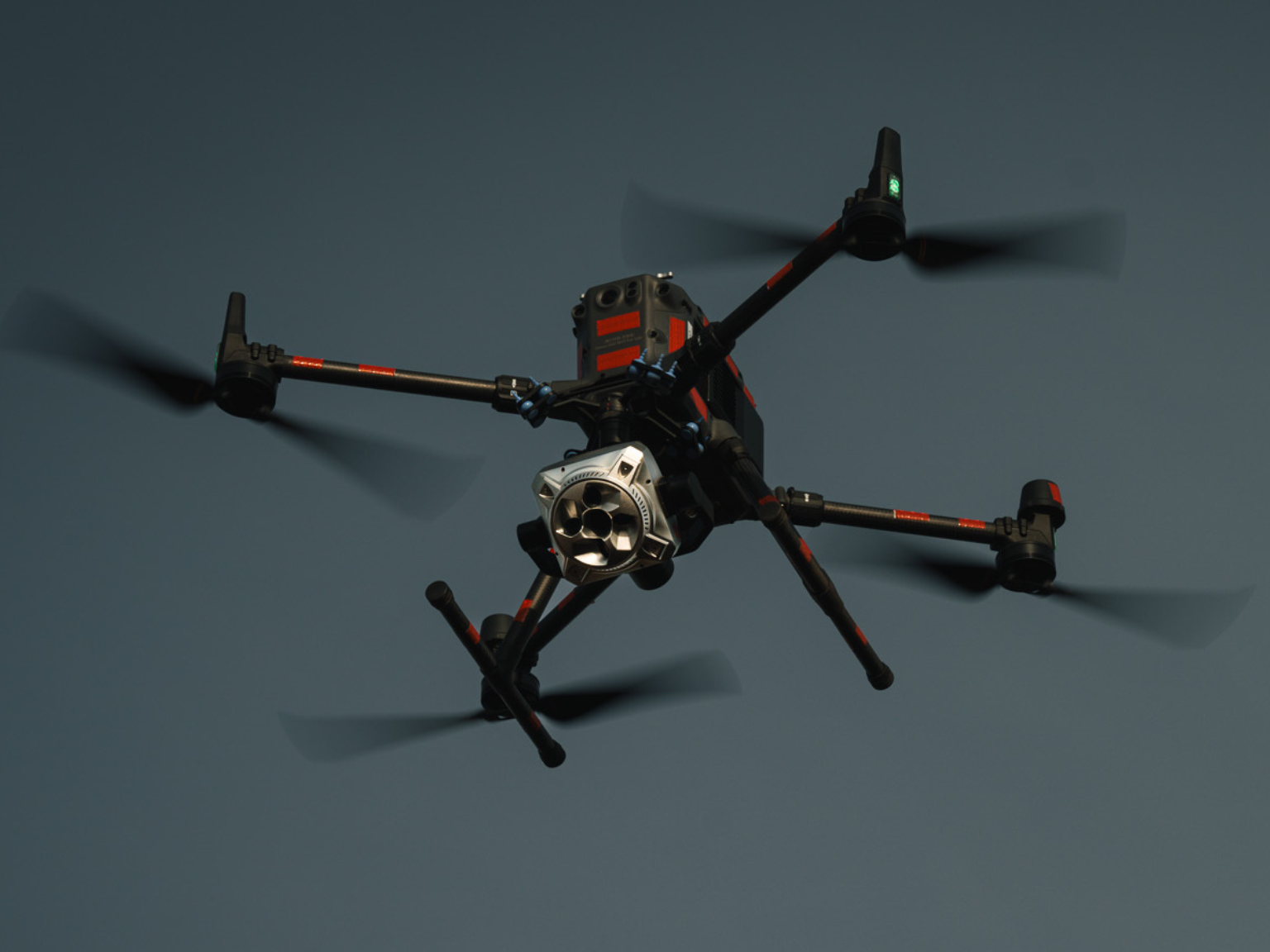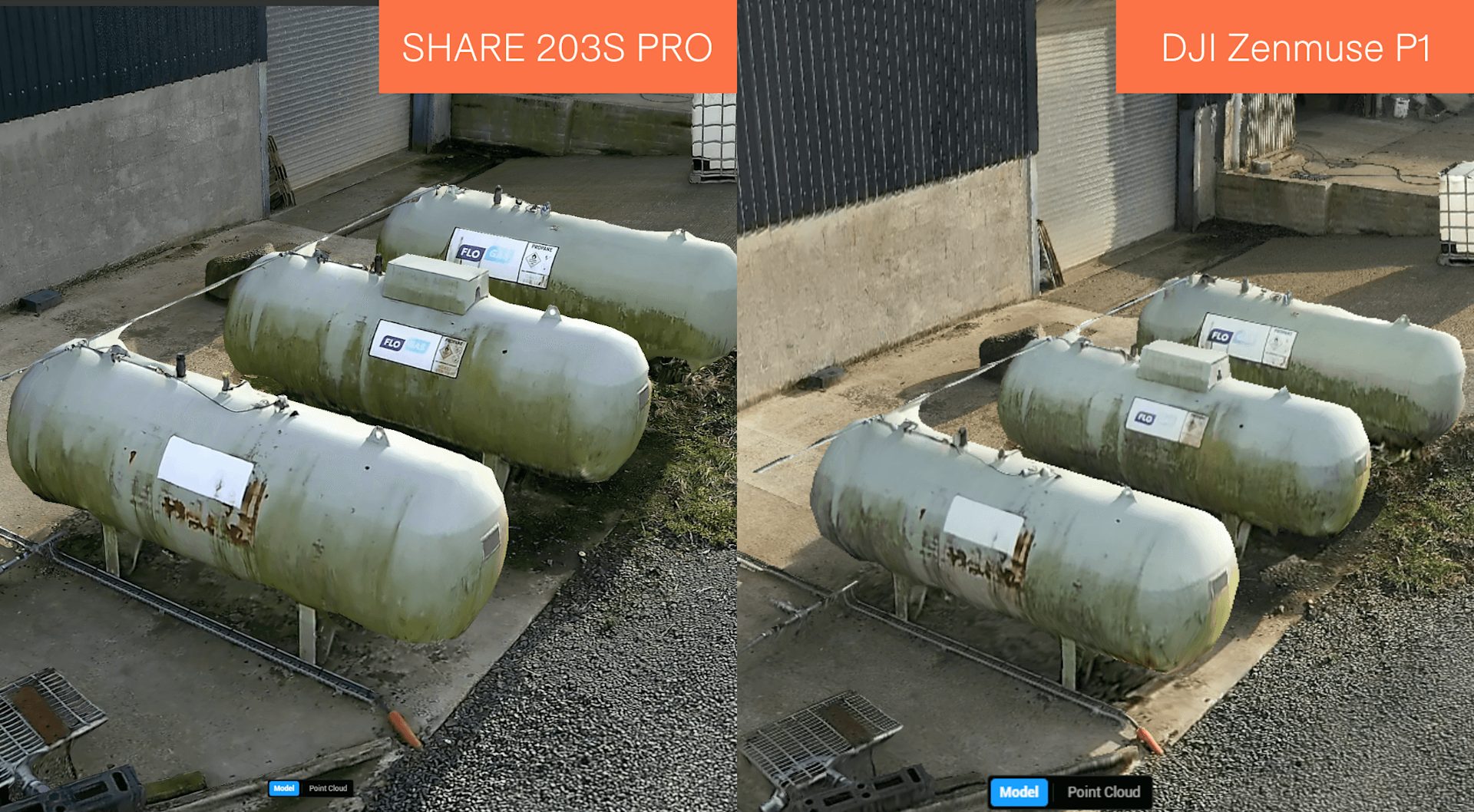
Products
Boost Drone Survey Efficiency With SHARE 203S PRO Oblique Camera
Exclusive datasets collected by heliguy™ demonstrate how the SHARE 203S PRO can increase the speed of drone surveys by more than 70%.
Exclusive datasets collected by heliguy™ show how the SHARE 203S PRO helps to enhance the speed of drone surveys - especially useful for large-area mapping missions;
The camera is a multi-oblique mapping payload - featuring five lenses with a total resolution of 225MP and os able to capture nadir and oblique imagery in a single pass;
Datasets demonstrate the data-capture quality of the 203S PRO, with 3D models consisting of a high level of detail;
The SHARE 203S Pro - compatible with the DJI M350 RTK/M300 RTK - can be purchased from heliguy™. It is also available for trials. The in-house surveying team can help organisations integrate it within their workflows.
The SHARE 203S PRO camera can increase the speed of drone surveys by more than 70% - exclusive datasets collected by heliguy™ show.
In one example, the multi-oblique mapping payload took 37 minutes to map the 17 hectare University of Warwick site, compared to 2 hours and 19 minutes with a single lens system conducting an oblique flight route.
And the speed at which the survey was completed did not compromise data quality - as this accompanying 3D model of the university shows.
During this particular project, the camera achieved a mean reprojection error of 0.885px. The data was tied with established ground control, maintaining a sub-10mm horizontal and vertical error across 18 out of 20 control points.
The payload’s increased efficiency is particularly suited to large-area mapping. This blog takes a deeper dive into the efficiency gains of the 203S PRO, using datasets gathered by the heliguy™ in-house survey department.
The camera is compatible with the DJI M350 RTK and DJI M300 RTK and can be purchased or hired from heliguy™. The geospatial team can help companies integrate it within their workflows.
What Makes The SHARE 203S PRO More Efficient?
The SHARE 203S PRO is equipped with a five-lens oblique camera system. Its multi-lens array means it can collect nadir and oblique imagery during a single flight, compared to having to fly multiple passes to gather data at different angles.

Each lens is 45MP, giving the payload a total resolution of 225MP. This high level of resolution enables operators to achieve low GSD (Ground Sample Distance) while flying higher - increasing the speed of the mapping mission.
For instance, our tests showed that the 203S PRO can obtain a ground sample distance (GSD) of 0.6cm from a flight height of 60m.
Meanwhile, the camera’s gimbal technology maintains the stability in pitch, roll and yaw - meaning that the camera remains perpendicular to the ground when operating at speeds of 15m/s.
Testing The Efficiency Of The SHARE 203S PRO
Having flown the SHARE 203S PRO, our survey team has been impressed by the payload’s efficiency and the quality of the data. To highlight this, we pitted it against the DJI Zenmuse P1 photogrammetry camera: Conducting like-for-like flights at multiple sites to compare the mapping speed of both payloads.

Like the 203S PRO, the P1 integrates with the DJI M300 Series.
And while the P1 is a single lens system, its Smart Oblique feature enables the gimbal to capture nadir and oblique imagery in one pass.
The P1 can be used with interchangeable lenses (available separately) to enable different focal lengths - with 24mm, 35mm, and 50mm options available - whereas the SHARE’S five-camera array is a fixed focal length.
The table below provides an overview of the key specifications of the two cameras.
SHARE 203S PRO | DJI Zenmuse P1 | |
|---|---|---|
Size | 130 x 130 x 99.5mm | 198 x 166 x 129 mm |
Weight | 830g; 1,280g (with gimbal) | Approx. 800 g |
IP Rating | IP5X | IP4X |
Effective Pixels | Single Lens: 45MP; Total (five lenses): 225MP | 45MP |
Sensor | 36 x 24mm (full frame); Pixel size: 4.4um | 35.9 x 24 mm (full frame); Pixel Size: 4.4 μm |
Image Size | 8192 x 5460 | 8192 x 5460 |
Lens | Oblique: 56mm; Normal incidence: 40mm | Interchangeable lenses: DJI DL 24mm F2.8 lens; DJI DL 35mm F2.8 lens; DJI DL 50mm F2.8 lens; |
Shutter Speed | 1/500; 1/640; 1/1000; 1/1250 | Mechanical Shutter Speed: 1/2000-1s; Electronic Shutter Speed: 1/8000-1s |
When it comes to pricing, the SHARE 203S PRO is a more expensive camera than the P1. Contact us for pricing.
Test One: Northumberland Farm
Our first test site was at a farm in Northumberland. The area mapped by both payloads was 2.2ha. The following parameters were set for each payload:
Flight Altitude: 40m
Flight Speed: 3.5m/s.
Overlap: 70% side; 80% front.
The test showed that the 203S PRO completed the survey 30 minutes quicker than the P1. The key details were:
SHARE 203S PRO | DJI Zenmuse P1 | |
|---|---|---|
Flight Time | 18m 11s | 48m 10s |
Number of Flights | 1 | 2 |
GSD (cm/pixel) | 0.44 | 0.72 |
Image Count | 4,005 | 2,107 |
With the SHARE, a 25 metre margin/offset was applied to flight boundary to ensure all oblique angles were captured.
And so - as the results show - the 203S PRO won the race. But what about the quality of the data?
While the P1 produced a clear and detailed dataset, the enhanced total resolution of the 203S PRO helped to create an even more robust 3D model with an extra level of clarity - as shown by this series of comparison screengrabs.
In these images, the P1 does a decent job replicating the scene…

…but the SHARE model has that additional detail, ie, the enhanced definition on the tank, as well as the facades of the barn and the shed.

Meanwhile, in this side-by-side image, there doesn’t look too much difference between the datasets…

…but on closer inspection, when zooming in, look at the clarity of the word ‘propane’ on the gas cylinder in the 203S PRO dataset, compared to the P1 version, which is more blurry and virtually impossible to make out.

And finally, in these comparison images of the building roof…


…the P1 model has plenty of detail, but in the 203S PRO image, each roof slate is more clearly defined. For instance, the bottom left roof tile in the P1 model looks warped, whereas the same tile in the SHARE dataset has a more complete and lifelike form.
Test Two: Hospital
The next site - at a hospital (the exact location cannot be disclosed) - represented a bigger area than the Northumberland farm, showing the benefit of deploying the 2033S PRO for large area mapping jobs.
The size of the site was 26.9 hectares - although the 203S PRO actually mapped 32.2ha because a 25 metre offset was applied to the survey boundary to ensure all oblique features were captured.
The flight parameters were:
Altitude: 60m
Speed: 4.5m/s
Overlap: 70% side; 80% front
Lens: 203S PRO - 40m nadir, 56mm oblique; P1 - 50mm.
Flying by these settings, the 203S PRO collected the data more than six hours quicker than the P1! The key stats are listed in the table below.
SHARE 203S PRO | DJI Zenmuse P1 | |
|---|---|---|
Flight Time | 1hr 33m | 8hr 5m |
Oblique GSD (cm/pixel) | 0.55 | 0.62 |
Images | 20,845 | 27,073 |
Covering in excess of 26 hectares, the subsequent 3D models were meaty affairs. The processing time was fairly similar for both payloads, and took three days to process.
So, what of the data?
These comparison images show the difference in the 3D models between the P1 and the 203S PRO.


The images show that, once again, while the P1 has plenty of detail, the 203S PRO carries that extra layer of information, with features such as the window frames and the roof tiles more defined.
Test Three: University of Warwick
In this test, we mapped the 17-hectare University of Warwick site.
For this scenario, we ensured both payloads achieved a GSD of 0.6cm. It meant that the 203S PRO was flown at 60m altitude, compared to the lower height of 44m with the P1. There was a big difference between the data capture time - with the 203S PRO completing the mission 1 hour and 42 minutes quicker.
The key details are outlined below.
SHARE 203S PRO | DJI Zenmuse P1 | |
|---|---|---|
Flight Time | 37 minutes | 2 hours 19 minutes |
Number Of Battery Swaps | 1 | 8 |
Image Count | 8,500 | 7,863 |
Summary
The SHARE 203S PRO is a powerful payload for improving the efficiency of drone mapping - especially useful for surveying large areas.
And as demonstrated by the heliguy™ datasets, this survey speed does not compromise data quality or accuracy - with the payload creating robust and highly-detailed 3D models.
Pitting it against the P1 was not designed to down-play the DJI payload: Rather showcase the enhanced efficiency of the 203S PRO.
After all, the P1 has become the go-to surveying camera for many drone programmes: In its own right, it offers fast surveying and produces high-fidelity datasets. And for those with a requirement for only orthomosaics, then the single lens system of the P1 makes sense.
Then there’s the difference in price between the two cameras - and whether the SHARE’s enhanced efficiency and the extra detail are worth the additional outlay. This will boil down to personal preference.
But companies willing to invest that bit more and opt for the 203S PRO will be rewarded with an extremely efficient and effective mapping solution.
The 203S PRO can be purchased from heliguy™. It is also available for client trials. For more details, contact us.
